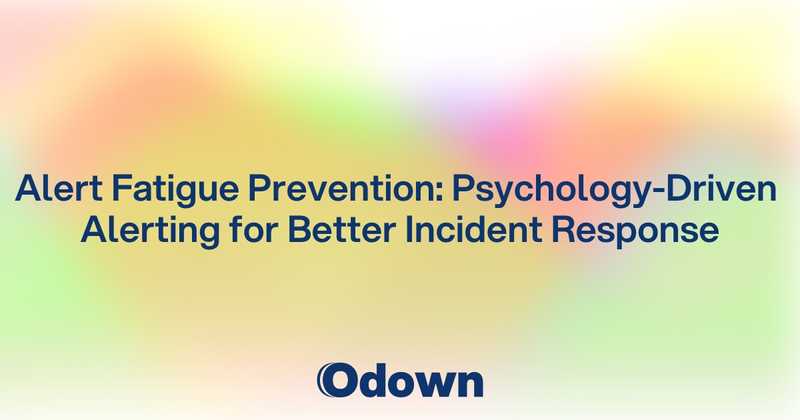Alert Fatigue Prevention: Psychology-Driven Alerting for Better Incident Response
Your phone buzzes with the 47th alert today. It's 2 AM, you're exhausted, and you instinctively silence the notification without reading it. Tomorrow, you'll discover that this ignored alert indicated a critical system failure that cost your company thousands of dollars in lost revenue.
Alert fatigue isn't just an operational problem---it's a psychological phenomenon that makes teams less effective at protecting critical systems. When people receive too many alerts, especially false positives, they develop learned helplessness and start ignoring all notifications, including genuinely critical ones.
The human brain isn't designed to maintain constant vigilance. Effective alerting systems work with human psychology rather than against it, ensuring that alerts capture attention when they matter while preserving team mental health and effectiveness.
Intelligent monitoring platforms incorporate psychological principles into alert design to reduce fatigue while improving response effectiveness. But creating psychologically sound alerting requires understanding how people process information under stress and designing systems that support human decision-making.
Alert Fatigue Psychology: Why Too Many Alerts Make Teams Less Effective
Understanding the psychological mechanisms behind alert fatigue helps explain why traditional alerting approaches often backfire and how to design better systems.
The Neurological Basis of Alert Fatigue
Alert fatigue isn't just about being annoyed by notifications---it involves real changes in how the brain processes information:
Habituation occurs when the brain stops responding to repeated stimuli that don't require action. People naturally tune out sounds, sights, or sensations that occur frequently without consequences. Alert systems that cry wolf trigger this protective mechanism.
Cognitive overload happens when people receive more information than they can process effectively. During incidents, teams often get flooded with related alerts that all indicate the same underlying problem, overwhelming their ability to process and respond appropriately.
Stress response degradation affects decision-making quality when people are constantly on high alert. Chronic exposure to alerts triggers stress responses that, over time, reduce cognitive performance and increase the likelihood of mistakes.
Decision Fatigue and Alert Processing
The quality of alert responses degrades as people make more decisions throughout the day:
Decision quality deterioration happens as people make numerous alert-related decisions. The first alert of the day gets careful analysis, while the twentieth might get a cursory glance and inappropriate dismissal.
Choice paralysis occurs when alerts provide too many options or unclear guidance about appropriate responses. Faced with ambiguous alerts, people often delay action or choose inappropriate responses.
Mental model breakdown happens when people develop incorrect assumptions about system behavior based on frequent false positives. Teams might assume alerts are usually wrong, leading them to dismiss genuine problems.
Social and Team Dynamics
Alert fatigue affects not just individuals but entire team dynamics and culture:
Responsibility diffusion occurs when too many people receive the same alerts. Everyone assumes someone else will handle the issue, leading to delayed or missed responses.
Alert normalization happens when teams develop tolerance for constant alerts and begin treating abnormal conditions as normal. This cultural shift reduces overall system reliability over time.
Burnout acceleration occurs when constant alerting contributes to work stress and eventual team member departure. High alert volumes contribute to unsustainable on-call experiences that drive talented people away.
Intelligent Alerting: Machine Learning and Context-Aware Notifications
Modern alerting systems use artificial intelligence and contextual information to reduce noise while improving the quality and relevance of notifications.
Machine Learning-Based Alert Filtering
ML systems can learn patterns that distinguish actionable alerts from noise:
Historical pattern analysis trains models to recognize which alerts typically require action versus which resolve themselves. Machine learning can identify patterns in alert resolution that humans might miss.
Contextual classification considers current system state, time of day, recent deployments, and other factors when determining alert severity. The same metric threshold might be normal during peak hours but concerning during low-traffic periods.
False positive prediction models learn to identify alerts that are likely to be false positives based on historical data and current context. These models can suppress or de-prioritize alerts that are statistically unlikely to require action.
Context-Aware Alert Enhancement
Intelligent alerting systems provide context that helps responders make better decisions faster:
Business impact correlation shows how technical alerts relate to business metrics like revenue, user experience, or customer satisfaction. Understanding business impact helps teams prioritize response efforts appropriately.
Related event aggregation groups related alerts into coherent incident narratives. Instead of receiving 15 separate alerts about the same database outage, teams get one comprehensive alert that explains the situation.
Remediation suggestion systems provide guidance about appropriate responses based on similar past incidents. Context-aware systems can suggest runbooks, escalation paths, or automated remediation options.
Adaptive Alert Thresholds
Smart alerting systems adjust thresholds based on changing conditions rather than relying on static values:
Time-based threshold adjustment accounts for predictable patterns in system behavior. Alert thresholds for web traffic should be different during business hours versus overnight.
Load-proportional alerting adjusts expectations based on current system load. Error rates that are normal during peak traffic might be concerning during low-usage periods.
Seasonal threshold adaptation accounts for longer-term patterns like holiday shopping seasons, monthly business cycles, or other predictable variations in system behavior.
Alert Prioritization: Severity Levels and Business Impact Classification
Effective alert prioritization ensures that the most important issues get immediate attention while less critical problems are handled appropriately without overwhelming responders.
Severity Classification Systems
Clear severity levels help teams understand how to respond to different types of alerts:
Critical alerts indicate immediate threats to system availability or data integrity. These alerts should wake people up at night and trigger immediate response procedures. Critical alerts should be rare---if everything is critical, nothing is critical.
Warning alerts indicate problems that need attention during business hours but don't require immediate response. These alerts help teams stay ahead of problems before they become critical.
Informational alerts provide context and trending information that helps with capacity planning and optimization but doesn't require immediate action. These alerts should be easily accessible but shouldn't interrupt other work.
Business Impact Integration
Alert prioritization should consider business impact rather than just technical severity:
Revenue impact classification prioritizes alerts based on potential financial consequences. An e-commerce checkout system failure deserves higher priority than a reporting system problem.
Customer experience correlation considers how technical problems affect user experience. Backend system issues that don't impact users might be less urgent than frontend problems with minor technical impact.
Compliance and regulatory impact factors in legal and regulatory consequences of different types of failures. Security-related alerts might require immediate attention due to compliance requirements even if technical impact is limited.
Dynamic Priority Adjustment
Alert priority should adapt based on current context and changing conditions:
Incident escalation automatically increases alert priority when problems persist or worsen over time. A warning-level alert that continues for extended periods might escalate to critical status.
Dependency-based prioritization considers how problems in one system might affect dependent systems. A database slowdown might start as a warning but escalate if it begins affecting customer-facing applications.
Time-sensitive adjustments account for business cycles and critical periods. The same technical problem might have different business impact during peak shopping seasons versus quiet periods.
Team Alert Management: Rotation, Escalation, and Burnout Prevention
Sustainable alerting requires team management strategies that distribute load fairly while ensuring appropriate expertise is available for different types of problems.
On-Call Rotation Design
Well-designed on-call rotations balance coverage needs with individual sustainability:
Rotation frequency affects both coverage quality and individual stress levels. Weekly rotations provide sufficient continuity for complex issues while limiting individual burden, but some teams benefit from shorter or longer cycles.
Skill-based rotation assignment ensures that people with appropriate expertise handle specific types of alerts. Database alerts might route to database specialists, while application alerts go to development teams.
Follow-the-sun coverage strategies distribute on-call responsibilities across global teams to provide 24/7 coverage without requiring anyone to work night shifts regularly.
Escalation Path Optimization
Clear escalation procedures ensure that alerts reach appropriate responders without unnecessary delays:
Automatic escalation timers ensure that unacknowledged alerts escalate to secondary responders. Escalation timing should account for alert severity and expected response complexity.
Expertise-based escalation routes complex problems to team members with relevant knowledge. Not every alert needs the same level of expertise, and routing should match problem complexity with responder capability.
Cross-team escalation procedures handle alerts that span multiple teams or require coordination between different groups. Clear escalation paths prevent alerts from getting lost between teams.
Burnout Prevention Strategies
Sustainable alerting practices protect team member wellbeing while maintaining system reliability:
Alert volume monitoring tracks how many alerts each team member receives and ensures fair distribution. Consistently high alert volumes for specific individuals indicate systemic problems that need addressing.
Recovery time protection ensures that team members get sufficient rest between on-call periods. Back-to-back on-call rotations or excessive alert volumes during supposed off-hours contribute to burnout.
Alert quality improvement focuses on reducing false positives and improving alert actionability. Teams should regularly review alert effectiveness and eliminate notifications that don't drive appropriate actions.
Effective alerting requires integration with comprehensive monitoring that provides the context needed for intelligent decisions. Dashboard design principles help ensure that alert responders have access to the information they need for effective incident response.
Ready to implement psychology-driven alerting that protects both your systems and your team? Use Odown and build alerting systems that work with human psychology to improve incident response while preventing alert fatigue and team burnout.



